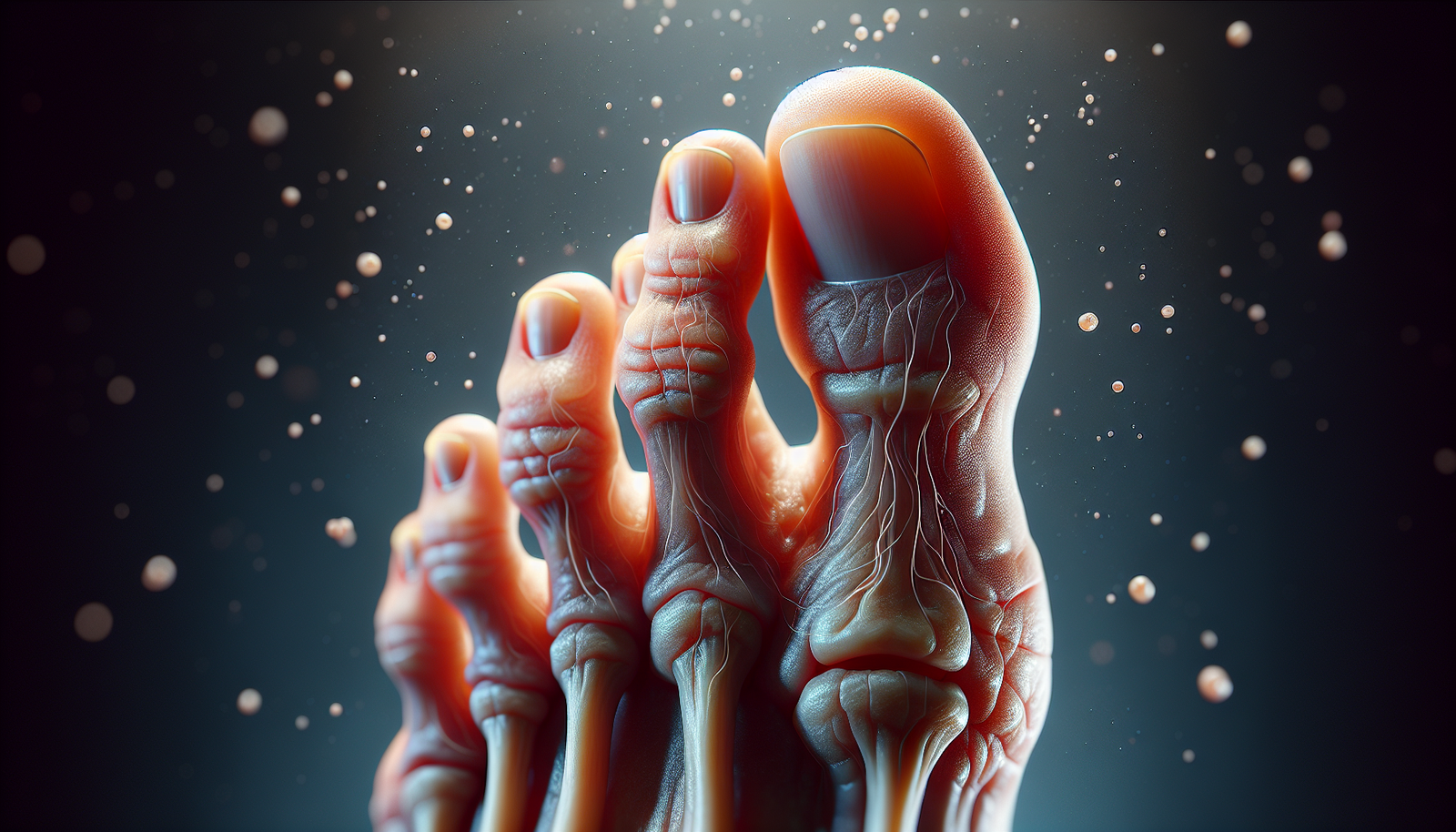Have you ever wondered why gout seems to have a particular fondness for attacking the big toe? It's a curious phenomenon that has puzzled many. In this article, we'll explore the reasons behind this peculiar nature of gout and shed light on the science behind why the big toe is often the unfortunate target of this painful condition. So, grab a cup of tea, sit back, and let's unravel the mystery of why gout sets its sights on your big toe!
Understanding Gout
Gout is a type of arthritis that is characterized by sudden and severe attacks of pain, inflammation, and tenderness in the joints. It is caused by the buildup of uric acid crystals in the joints, which leads to inflammation and the formation of painful tophi. Gout most commonly affects the big toe, but it can also occur in other joints such as the ankles, knees, elbows, and fingers. Understanding the causes and progression of gout is essential for effectively managing and preventing this painful condition.
What is gout?
Gout is a form of arthritis that results from the accumulation of uric acid crystals in the joints. Uric acid is a waste product that is produced when the body breaks down purines, which are substances found in certain foods and beverages. Normally, uric acid dissolves in the blood and is excreted from the body through the kidneys. However, when there is an excess of uric acid or the body is unable to eliminate it efficiently, it can build up and crystallize in the joints, leading to the development of gout.
Common symptoms of gout
Gout is characterized by sudden and intense pain, swelling, redness, and tenderness in the affected joint. These symptoms usually occur at night and can last for a few days to a few weeks. Gout attacks often come on suddenly, without warning, and the pain can be excruciating. Other symptoms may include fever, fatigue, and inflammation of the surrounding tissues. It is important to seek medical attention if you experience these symptoms to receive a proper diagnosis and treatment.
Disease progression and stages of gout
Gout typically progresses through four stages: asymptomatic hyperuricemia, acute gouty arthritis, intercritical gout, and chronic tophaceous gout. In the first stage, asymptomatic hyperuricemia, there are no symptoms, but uric acid levels in the blood are elevated. Acute gouty arthritis is the second stage, characterized by sudden and severe gout attacks. Intercritical gout refers to the period between attacks when there are no symptoms. Chronic tophaceous gout is the most advanced stage, where tophi, or collections of uric acid crystals, form in the joints and surrounding tissues. Understanding the stages of gout can help guide treatment decisions and management strategies.
The Culprits: Uric Acid and Purines
Definition and role of uric acid
Uric acid is a byproduct of the breakdown of purines, which are naturally occurring substances found in many foods and beverages. Uric acid is normally dissolved in the blood and excreted from the body through the kidneys. It acts as an antioxidant and helps to protect against damage caused by free radicals. However, when there is an excess of uric acid in the body or the kidneys are unable to eliminate it efficiently, it can accumulate and form crystals in the joints, leading to gout.
Impact of purines on uric acid levels
Diet plays a crucial role in uric acid levels, as certain foods and beverages are high in purines. When purine-rich foods are consumed, the body breaks down purines into uric acid. Therefore, a diet high in purines can lead to elevated uric acid levels in the blood. Foods that are particularly high in purines include organ meats, shellfish, red meat, alcohol (especially beer), and sugary drinks. Limiting the consumption of these foods can help reduce the risk of gout attacks.
How uric acid leads to gout
When uric acid levels rise in the blood and exceed the saturation point, the excess uric acid can crystallize and deposit in the joints, leading to inflammation and the development of gout. These uric acid crystals trigger an immune response, causing pain, swelling, and tenderness. The crystals can also accumulate and form tophi, which are visible lumps under the skin. Over time, repeated gout attacks can cause joint damage and deformity if left untreated.
Correlation between Gout and the Big Toe
Frequency of gout attacks in the big toe
The big toe is the most commonly affected joint in gout. Approximately 50% of gout cases involve the big toe joint, also known as the metatarsophalangeal (MTP) joint. Gout attacks in the big toe can be extremely painful and debilitating, making it difficult to walk or wear shoes. The frequency of gout attacks in the big toe can vary from individual to individual, with some people experiencing occasional attacks and others having more frequent episodes.
Reasons for gout's affinity for the big toe
There are several reasons why gout tends to target the big toe joint. First, the big toe joint is one of the farthest joints from the heart, which means it receives less blood flow and is more prone to temperature fluctuations. This can contribute to the crystallization of uric acid in the joint, triggering gout attacks. Additionally, the big toe joint bears a significant amount of weight and is subject to constant pressure and stress, which can increase the risk of inflammation and joint damage. Finally, the shape and structure of the big toe joint, with its limited range of motion and tight spaces, make it more susceptible to the deposition of uric acid crystals.
Role of Lower Body Temperature in Gout Attacks
Impact of body temperature on uric acid crystallization
Uric acid is more likely to crystallize and form urate crystals at lower temperatures. The solubility of uric acid decreases as the temperature drops, leading to the precipitation of crystals in the joints. The big toe joint, being one of the coolest areas of the body, is particularly vulnerable to uric acid crystallization and subsequent gout attacks. Lower body temperature in the big toe joint provides an ideal environment for the formation and accumulation of urate crystals.
Why the big toe has a lower body temperature
The big toe joint, as one of the peripheral joints in the body, receives less blood flow compared to more central joints. This reduced blood flow results in a lower body temperature in the big toe. Additionally, the big toe is often exposed to cooler temperatures due to its location at the end of the extremity. These factors contribute to the lower body temperature in the big toe, making it more prone to uric acid crystallization and gout attacks.
Anatomy of the Big Toe and Gout Vulnerability
Structure of the big toe
The big toe, also known as the hallux, is the largest and strongest toe in the foot. It consists of two phalanges, the proximal and distal, which are connected by the metatarsophalangeal (MTP) joint. The MTP joint allows the big toe to move up and down and provides stability during walking and running. The intricate structure of the big toe joint, with its multiple ligaments, tendons, and bones, makes it susceptible to the deposition of uric acid crystals and the development of gout.
Role of toe joint in being a target for gout
The unique anatomy and function of the big toe joint make it a common target for gout. The limited range of motion in the big toe joint means that it experiences repetitive stress and pressure when walking or running. This constant stress can lead to joint inflammation and damage, increasing the likelihood of uric acid crystal formation and gout attacks. Additionally, the small size and tight spaces in the joint make it easier for urate crystals to accumulate and cause pain and swelling.
Gout Attacks: Understanding the Pain
Why gout attacks cause pain
Gout attacks are characterized by intense and excruciating pain. The pain is primarily caused by the presence of uric acid crystals in the joint, which can irritate the surrounding tissues and trigger an inflammatory response. Uric acid crystals stimulate the release of inflammatory chemicals, such as cytokines and leukotrienes, which cause swelling, redness, and pain. The pain in gout attacks can be debilitating and often leads to a decreased quality of life.
Severity of pain in gout attacks
The severity of pain in gout attacks can vary from mild to severe, with some individuals experiencing excruciating pain that is comparable to childbirth or a broken bone. The pain is often described as a throbbing or pulsating sensation that is accompanied by swelling and tenderness. The intensity and duration of pain in gout attacks can depend on factors such as the individual's pain threshold, the extent of inflammation, and the promptness of treatment. Prompt medical intervention is essential to alleviate pain and prevent further joint damage.
Risk Factors for Gout Attacks in Big Toe
Dietary habits
Diet plays a significant role in the development and recurrence of gout attacks in the big toe. Consuming foods that are high in purines, such as organ meats, shellfish, red meat, and alcohol, can increase uric acid levels in the body and trigger gout attacks. Moreover, a diet that is high in fructose, found in sugary drinks and foods, has also been associated with an increased risk of gout. Adopting a healthy diet that is low in purines and fructose can help reduce the risk of gout attacks in the big toe.
Lifestyle factors
Certain lifestyle factors can contribute to the occurrence of gout attacks in the big toe. Obesity and excessive weight gain can increase the risk of gout, as they are associated with elevated uric acid levels. Physical inactivity and sedentary behavior can also contribute to gout, as exercise helps to normalize uric acid metabolism. Similarly, excessive alcohol consumption, particularly beer, can increase the likelihood of gout attacks. Making lifestyle modifications such as maintaining a healthy weight, engaging in regular physical activity, and moderating alcohol consumption can help prevent gout attacks.
Genetic predisposition
Genetics can also play a role in gout susceptibility. Some individuals have a genetic predisposition to produce or eliminate uric acid less efficiently, resulting in elevated uric acid levels and an increased risk of gout attacks. Family history of gout can be an important risk factor to consider. While genetic factors cannot be changed, awareness of the predisposition can help in implementing preventive measures and regular monitoring to manage gout attacks effectively.
Diagnostic Methods for Gout in the Big Toe
Medical history assessment
The first step in diagnosing gout in the big toe is a thorough assessment of the patient's medical history. This includes evaluating the frequency and severity of gout attacks, previous medical conditions, medications, and family history of gout. Gathering detailed information about the symptoms and their patterns can help in determining whether gout is the likely cause of the symptoms.
Physical examination
A physical examination is conducted to assess the affected joint and look for signs of inflammation, such as redness, swelling, and tenderness. The doctor may also examine other joints to rule out other possible causes of the symptoms. Physical examination is an essential component of the diagnostic process and can provide valuable information to support or refute a diagnosis of gout.
Imaging tests
Imaging tests, such as X-rays, ultrasound, or MRI scans, may be performed to evaluate the joint and look for evidence of uric acid crystal deposition or joint damage. These tests can help confirm the presence of gout and determine the extent of joint involvement. Imaging tests are particularly useful in detecting tophi, which are collections of uric acid crystals that can form in and around the joint.
Joint fluid test
A joint fluid test, also known as arthrocentesis, involves the extraction of fluid from the affected joint for analysis. This procedure is performed to confirm the presence of uric acid crystals in the joint fluid, which is a definitive diagnostic criterion for gout. The joint fluid test can also help rule out other possible causes of joint pain, such as infection or other types of arthritis.
Treatment Options for Gout Attacks in the Big Toe
Medications for managing gout
Medications are often prescribed to manage gout attacks in the big toe and prevent future episodes. Nonsteroidal anti-inflammatory drugs (NSAIDs) are commonly used to alleviate pain and reduce inflammation during acute gout attacks. Colchicine, a medication that reduces the body's inflammatory response, can also be prescribed to relieve pain and prevent recurrent flare-ups. In some cases, corticosteroids may be injected directly into the affected joint to provide rapid pain relief. Additionally, medications such as xanthine oxidase inhibitors and uricosurics may be prescribed to lower uric acid levels and prevent gout attacks in the long term.
Lifestyle modifications
In addition to medication, making certain lifestyle modifications can help manage gout attacks in the big toe. Maintaining a healthy weight through a balanced diet and regular exercise can reduce the risk of gout and lower uric acid levels. Avoiding trigger foods that are high in purines, such as organ meats and shellfish, and limiting alcohol consumption can also help prevent gout attacks. Staying well-hydrated by drinking plenty of water and reducing consumption of sugary drinks can further support gout management. Lifestyle modifications are important for long-term gout management and reducing the frequency and severity of gout attacks.
Alternative and complementary remedies
Some individuals may choose to explore alternative and complementary remedies to manage gout attacks in the big toe. These include herbal supplements, such as cherry extract or turmeric, which have been suggested to have anti-inflammatory properties. However, it is important to note that the effectiveness of these remedies is not scientifically proven, and they should be used with caution. It is always advisable to consult with a healthcare professional before trying any alternative or complementary remedies.
Preventing Gout Attacks in the Big Toe
Effective strategies for reducing uric acid levels
Preventing gout attacks in the big toe involves managing and reducing uric acid levels in the body. This can be achieved through lifestyle modifications, such as adopting a low-purine diet, limiting alcohol consumption, maintaining a healthy weight, and staying physically active. In some cases, medications may be prescribed to help lower uric acid levels. Regular monitoring of uric acid levels through blood tests can help assess the effectiveness of treatment and guide management strategies.
Importance of regular health check-ups
Regular health check-ups are important for individuals with gout, particularly those who have experienced gout attacks in the big toe. These check-ups allow healthcare professionals to monitor uric acid levels, assess joint health, and evaluate the effectiveness of treatment. Regular check-ups also provide an opportunity to discuss any concerns or changes in symptoms and adjust the treatment plan accordingly. Working closely with a healthcare professional can help in managing gout effectively and reducing the risk of gout attacks.
Role of diet and exercise in gout prevention
Diet and exercise play a crucial role in preventing gout attacks in the big toe. Adopting a low-purine diet, which involves limiting the consumption of purine-rich foods such as red meat, organ meats, and shellfish, can help reduce uric acid levels. Incorporating regular exercise, such as walking, swimming, or cycling, can aid in weight management and promote overall health. Maintaining a healthy weight is particularly important, as obesity has been strongly associated with an increased risk of gout. By adopting healthy lifestyle habits and making conscious choices, individuals can effectively prevent gout attacks in the big toe.
In conclusion, gout is a painful condition characterized by the accumulation of uric acid crystals in the joints. While gout can affect various joints in the body, it has a particular affinity for the big toe. The frequency and severity of gout attacks in the big toe can vary, and understanding the underlying causes and risk factors is essential for effective management. In addition to medications, lifestyle modifications, such as adopting a low-purine diet, maintaining a healthy weight, and staying physically active, can help prevent gout attacks. Regular health check-ups and monitoring of uric acid levels are also important for long-term management and prevention of gout attacks in the big toe. By taking a comprehensive approach and implementing preventive strategies, individuals can minimize the impact of gout on their lives and improve their overall well-being.



